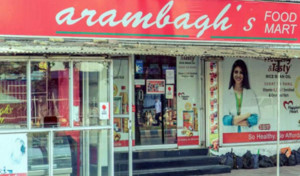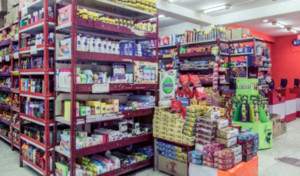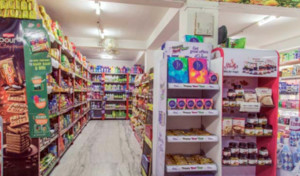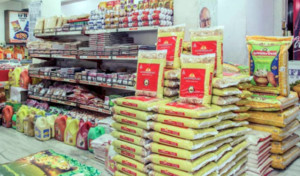Progressive Grocer speaks to Executive Director, Arambagh Foodmart Pvt. Ltd., Biyas Roy, about how a chain of stores selling processed and ready-to-eat chicken items has evolved into becoming one of the top three Food & Grocery retail chains in eastern India with a footprint across all major cities of Bengal. Arambagh stores occupy a format that is positioned between the neighbourhood kirana store and the larger supermarket, with average store size of 700 sq.ft. approximately.
Please share the growth journey of Arambagh Foodmart chain of stores over the years.
Arambagh Foodmart chain of convenience retail stores was started in the year 2000, following the concept of international ‘7-11’ chain. The first Foodmart was converted from the existing Arambagh’s Chicken chain of stores selling processed and ready-to-eat chicken items.
With the USPs of good quality, attractive promotions and location convenience, Arambagh Foodmart was a quick success. Stores have been steadily added over the years. In 2006-2007, there was a setback owing to the bird flu, and the company’s revenues – which used to come majorly from chicken and related items – plummeted, slowing the expansion rate for sometime.
In 2012, the Foodmart Division with 25 stores and a warehouse was incorporated into a separate company named Arambagh Foodmart Pvt Ltd. The first year was used to consolidate operations and set up processes, after which the number of stores increased steadily to the current 46 stores, which is planned to reach 53 by the end of FY 16-17.
 How do you look at your retail format as strengthening your business model?
How do you look at your retail format as strengthening your business model?
Arambagh Foodmart is the neighborhood supermarket – a unique format that positions itself between the neighborhood kirana store and the supermarket that offers modern ambience and attractive promotions. Our USPs are developed more in the line of convenience or ‘value for time’ along with value for money. Apart from attractive promotions, good quality grocery and competitive pricing, the strength of our format lies primarily in the location of the stores, and a bunch of convenience factors such as quick checkout, free home delivery for any order amount and order over telephone. With its footprint across all major cities of Bengal, Arambagh Foodmart is one of the top three retail chains in eastern India.
What do you feel are the marked differentiators of your stores that put them apart from the retail players in the same category?
One of the main differentiators for our stores has been their location. They are strategically located in densely populated localities yet at important junctions to attract the floating customers. About 90 per cent of the daily needs of a household are available within 10 minutes of reach, or are delivered free.
Another key differentiator has been the employee customer relationship. Many of our employees have been with us since the inception of the company as is a large percentage of customers. They have become a part of one big family. Elderly customers have depended on our staff for not just delivering their groceries, but also for suggesting buying options. Sometimes, our customers drop in just to have a quick chat over a cup of tea. Customers have truly made our stores a part of their household.
What kind of people frequent your stores and in which age group? Has the customer profile been changing in any way over the years?
Our customer demography comprises the middle class to upper-middle class. All age groups frequent our stores, but less of the young and affluent families who prefer a wide range and gourmet products. There is a captive base of aged customers who rely on our home deliveries. Over the years, we have seen an increase in the number of working couples who prefer telephonic order and home deliveries for their monthly groceries, and also in the number of men shopping alone or picking up essentials on their way back from office.
How much your location strategy has contributed to the success of your stores?
Our stores are located on main roads or first bylanes, within densely populated areas with car parks in front. We target a 70:30 ratio of catchment and floating base of customers. All our stores are standalone, and never located inside malls or shopping plazas. Since Arambagh Foodmart is a popular brand amongst the Bengali population, we try to choose areas with predominantly Bengali customers. We also open stores inside large residential complexes with more than 500 apartments.
Any interesting concepts or innovations that you have introduced at your stores?
When we started delivering to homes free of cost for any amount and any distance, many elderly couples were the first to become our loyal customers. Over time they started depending on our store employees so much that they asked them to deliver other shopping that they have done elsewhere and were unable to carry. Sometimes regular customers even entrust our employees to get the grocery arranged in their kitchen.
We have continued to provide this extra service to them which has largely helped us to retain this category of customers. We also provide a free item of the customer’s choice to all customers over a bill value, which has become more popular than any card-based loyalty and a deciding factor for many to shop from Arambagh Foodmart.
What are the trends in your stores for the major grocery categories?
One consistent trend noticed over the past 16 years is the preference for good quality staples. We sell high quality private label grocery and staples that are competitively priced but not low-cost, sales of which has never shown a decline. The parallel mid-range staples have not been popular despite lower cost. A recent trend has seen customers preferring savings through bigger packs and combo-packs. For example, sales of 25 kg rice has increased by 500 per cent and combo-packs by 200 per cent over the past two years. Then there is oil, which has consistently been the most price sensitive category fetching the lowest margin.
Tell us about your product basket. Which are the categories you specialise in as a retailer?
The product basket comprises of food and groceries – packaged and loose, fish, meat and poultry, toiletries, soft drinks, ice-cream and ready-to-eat snacks. We do not sell fresh vegetables and fruits. We have our own private label, which is our key strength. Grocery and staples is of very high quality and one of our footfall drivers. Our private brand – Arambagh Chicken – is also something that customers associate our chain with and the store brand has its own loyal base of customers. Stores that were converted from a solely chicken store have opening times as early as 8 am to accommodate customers seeking fresh chicken for the day’s need.
 Broadly speaking, what is the sales contribution from your major product categories?
Broadly speaking, what is the sales contribution from your major product categories?
Food (36 per cent) and grocery (26 per cent) combined contributes to 62 per cent of our sales, out of which 15 per cent is from our private label. Rice is the highest contributing category overall, having a 5 per cent share of overall sales. Chicken and related items – entirely private label – is the highest contributing group, comprising 11 per cent of our sales. Across which categories do you have store brands? Our private labels are our footfall drivers. We sell high quality staples and spices, and also chicken and related products like sausage, salami and ready to fry/ready to eat products.
Which new products would you like to introduce as private label?
We have recently started our own brand of tea, and plan to expand the range. We are also planning to move to non-food private labels, which have higher margins and for which customers are not brand-conscious.
Which are the new and emerging categories at your stores?
The frozen and chilled food category has had the most rapid growth at our chain. Due to a general trend towards quick snacks, and with the addition of new brands and a variety of veg and non-veg frozen snacks with attractive packaging, this category has shifted from being a shopping-list category to an impulse category. With good visibility in glass top/vertical or open freezers, this category has the potential to provide highest per sq. ft. sales.
Which are the fastest-moving product categories in your stores and which are the best-selling brands for such products?
The fastest moving product category is biscuits – Britannia and Bisk Farm are the best-selling brands in this category, followed by chocolates (Cadbury, Nestle), snacks (Fritolay), soft drinks (Coca-Cola) and pulses (loose unbranded). Rice contributes the most in terms of value, and it comes mostly from bulk packs of 25 kg.
What is your strategy for merchandise display and category management in your stores? How are the product sections arranged, what is the planogram and are these arrangements based on specific consumer insights?
We follow a no-frill store layout and merchandising. Entire stocks are kept on the shelves. The product sections are divided into four broad parts – grocery and staples, food, non-food, and chilled. Non-food is usually displayed across the glass, which is visible from outside. Single entrance cum exit is on one end of the front, with the billing section beside the entrance followed by the chilled section. This is to prompt the customer to pick up chilled and quick serve items while standing in the billing queue, as this section gives maximum impulse sale.
Children’s impulse products are also kept at child-eye level near the cash counter. New arrivals and promo items are given floor stacking wherever space permits.
Do you have any tie-ups or collaborations with brands for category insights and better category management?
We have tie-ups with most of the major brand owners on providing a share of shelf as per share of sale, and within-category display of SKUs.
 What are your expectations from food producers and brands and how can they become true category partners with retailers?
What are your expectations from food producers and brands and how can they become true category partners with retailers?
The only way food producers and brands can become true category partners with retailers is by consolidating their supply chain with that of the retailer. They can use the retailers’ sale-out data and sales projection to make production and stock planning across multiple layers of the producers’ supply chain. This hardly happens today, resulting in low fill rates.
As a retailer, what are you doing to innovate with your supply chain model and overcome the challenges of inventory and low fill rates?
Low fill-rate and frequent stock-outs have been the major challenges in a lean inventory model for a convenience store format. We have recently started working very closely with the brand owners to do joint assortment planning, sales and promotion planning tailored to our promotion calendar, and have integrated our supply chains by setting up a joint stock plan and delivery schedule to ensure minimum stockout and maximum sales during promotions.
What are you doing to promote your PLs?
We have employed several different strategies to promote private labels. Strategies such as sampling, combi packs, and in-store push sales prove most effective.
What are your processes and criteria for identifying new products and categories and your benchmarks for tying up with new vendors, suppliers and distributors?
We use several different processes to identify new sales categories: Customer feedback and competitor survey to name a few. Suggestion from existing vendors regarding new launches that have good focus and advertisement spend is another identifier. When we select new vendors, we ensure that their products have the pull factor, are already accepted in the market and that our stores have received queries about such products. We also ensure that vendors arrange for in-store special visibility and sampling if required.
How do you ensure that suppliers stick to quality standards and efficiency norms?
The quality of food is strictly controlled and monitored. Apart from checks of stock aging through system, damage/expiry and quality are monitored manually by a team of supervisors. There is a strict set of guidelines for vendors at the time of vendor enlistment – both for delivery of fresh stock as well as for return of old and expired stock. Stocks are not accepted at warehouse if there is any deviation from these norms.
What is the extent of your direct sourcing and how do you do it?
We purchase staples from the wholesalers and rice mills. Spices are procured from regions where the quality is best. We have a dedicated purchase team that follows a strict quality standard.
Please tell us about the customer feedback loop at your stores and if it has helped to improve various facets of store operations and merchandising?
Feedback or complaints are usually received directly by the Head of Retail Operations through email and message/call/WhatsApp. Our feedback email id and phone number are clearly displayed in each store. Senior supervisors personally meet customers to discuss his/her grievances and suggestions within 24 hours of receiving the email or message. Stores also have a feedback system related to products. Based on the feedback from customers, the store-wise product mix is updated periodically.
How liberal are you in trying out new offerings in your stores?
Since our stores are small in size, the best results are obtained by promoting a selective mix of products instead of an exhaustive one. We enlist close to 60-70 per cent of the new launches in the market, based on the suggestions from existing vendors. While we usually do not provide launching support for new brands, if a brand is smart and the product is good, we do take part in its first launch.
With e-commerce and m-commerce pulling ahead as more convenient and preferable mediums of shopping, are you doing anything special to beef up your presence on these channels?
Online retailing is particularly challenging in food and grocery where delivery time as well as freshness of food are critical and inventory management is a challenge. Frequent price changes, multiple price points, and lean level of shelf stock at small stores are further challenges. E-commerce is done through warehousing, and is not a natural extension of brick and mortar. A partnership model works best for us. We work with multiple online grocery delivery companies to top up our sales through their online orders and, in turn, off er our extensive network of stores for their pick-up, which reduces their delivery cost.
How do you look at the future potential of your store format and what do you think are its distinct advantages as well as the shortcomings over other retail formats?
Owing to changing demographics and with an increase in the number of nuclear families, working couples and elderly couples living alone, time has become an expensive commodity. Customers are unwilling to spend their time in unproductive work. Th e size of the category of customers that seek value in terms of not just price or promotions but also in terms of convenience is increasing. Moreover, we sell the daily essentials, which as a commodity is least affected by recession or economic instability.
As our stores are smaller in size, the sales velocity is higher than the super or hyper format, and the costs are significantly lower. This format has a potential to remain profitable if the basics are done correctly. The advantages of this model are many: low investment, of which is 90 per cent is recoverable, quick start within 20 days, break-even timeline of a year, to mention just a few advantages of this format. Th is format runs on almost just-in-time inventory that ensures quick inventory turn and better utilization of working capital.
Amongst the primary disadvantages are very low margin owing to a pure FMCG product basket, and the profit contribution from each store is small. Additionally, because of the small size, same store sale growth tends to stagnate within a few years.
 What is the scope for utilising and leveraging technology for your store format? What kind of technological initiatives and innovations have you introduced?
What is the scope for utilising and leveraging technology for your store format? What kind of technological initiatives and innovations have you introduced?
We work with a fully integrated software system that covers production, purchase, inventory management, retail sale, B2B sale, vendor management, accounts and taxation. Each process is automated and provides all necessary control measures. Inventory management is done through an automated replenishment system based on sales projection, lead time, required stock-cover and payment norms of vendors. To keep the inventory lean at all times, the replenishment system is dynamically managed to take care of purchase cycle and non-purchase cycle sales, promotional items, new launches etc.
What have been your learnings and experience as a retailer? Can you share some key learnings that you have gleaned over the years?
Over the last decade and a half, we have gained valuable insights on customer preferences and buying patterns. Th is, in turn, has helped us in efficiently choosing our product mix. One such key learning has been the expeditious sales of bulk produce such as 25 kg rice packs. Our customers are predominantly middle class and many of them do not own cars. By starting free home delivery, we have been able to attract customers and enabled them to buy bulk packs. As I mentioned earlier, a significant percentage of our rice sales comes from 25 kg packs.
Another insight into consumer preferences led us to adding sugar in the free list for higher bill value. Sugar is one of the staple items in a Bengali household. Getting it free was one star attraction and a determining factor for many housewives to shop from Arambagh Foodmart or increase the basket size to avail the offer.
 What is your roadmap for the future?
What is your roadmap for the future?
We are cautious with our expansion strategy and we do not expand too fast. There are many criterion that should be met to select a store. High rental costs is also a deterrent for fast expansion. We have recently entered the North Bengal market where we are the first exclusive grocery chain.
We plan to open 10-15 stores within next FY and promote the concept of convenience of shopping in that market. By 2020 we plan to have 70-75 stores in West Bengal, and venture into the eastern states where there is no modern format exclusive grocery retail chain yet.
Arambagh Foodmart on expansion mode, to take store count to 75 by 2020
All stores are located on main roads or
first by-lanes, within densely populated areas with car parks in front - never inside malls - and target a
70:30 ratio of catchment and
floating base of customers
Must Read



